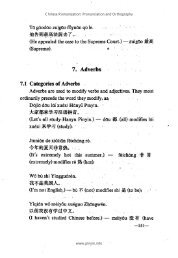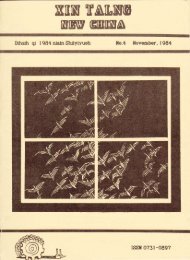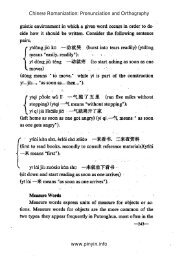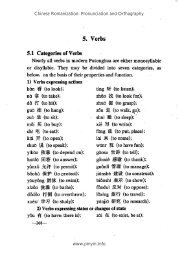Xin Tang 6 - Pinyin.info
Xin Tang 6 - Pinyin.info
Xin Tang 6 - Pinyin.info
- No tags were found...
Create successful ePaper yourself
Turn your PDF publications into a flip-book with our unique Google optimized e-Paper software.
11 JOHN OEFRANCISproduce the complete orthographic repertoire of 12 Vietnl2mesevowels. As a result, it averages about 1.5 of these additionalsymbols per syllable, twice the number in Chinese.The reilltive simplicity of Chinese wm become even greater if,as mllny advocate, tone indication is used only when necessary toavoid ambiguity. According to Vin Binyong (personalcommunication 217185), tests made on written materials indicatethat Chinese needs to add one of its four tone marks only on oneword (dr) in twenty. According to my own count, French with itsfive diacritics (cedilla and diaeresis; grave, acute, and circumflexaccents) actually odds one of these symbols on one word in six.It thus IIppellrs thllt if the Chinese III ways indicate tones theywould hllve to IIdd symbols only hilif liS often liS do the Vietnamese,and if they IIdd them only when necessllry they would have to do soless than a third as often as the French. Both the Vietnamese andthe French toke the writing of their little diacritics in their stride,faithfully adding them in virtulllly all circumstllnces, <strong>info</strong>rmlJl aswell as formal, much as we do in' dotting the letters i lind i andcrossing the letter 1. They IIppellr to be bothered hardly lit 1111about a feature of their writing the pllrallel of which engendersalmost panJnoid concern Imd contention in the Chinese field.It would be well for specialists in Chinese to ponder theVietnamese success in applying a phonemic writing to a languagewhich, heavily influenced as it was by Chinese, appears to havepresented problems--which turn out to be non-problems--closelyakin to those feared by our victims of homographobia. It would beespecially advisable to ponder the ricicule that outsiders expressregarding our preoccupation with problems of homography. Thefact of the matter is that our field is beset with egregiousmethodological errors noted in this paper that to my mind areextremely serious. They have led to much wasted effort inconsideration of ambiguity in Chinese and to a paralyzing fear ofhomography in phonemic writing.It is high time to end this state of affairs, which reflects badlyon our work, and to place our primary emphaSis on a methodologythat seeks to find occurrences of ambiguity in real-life situationsSome of these can be projected by a sound theoretical approach.










